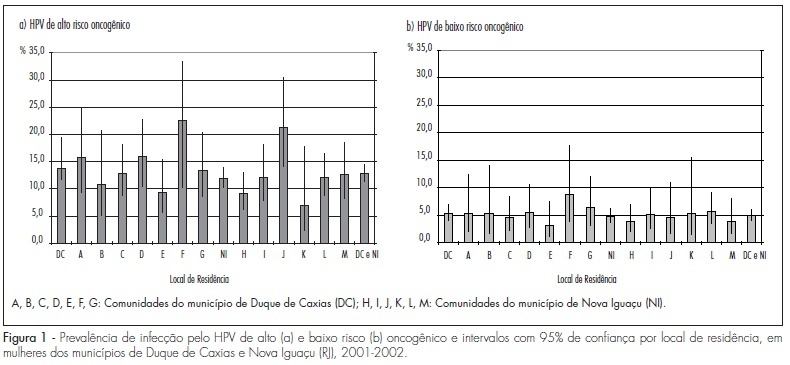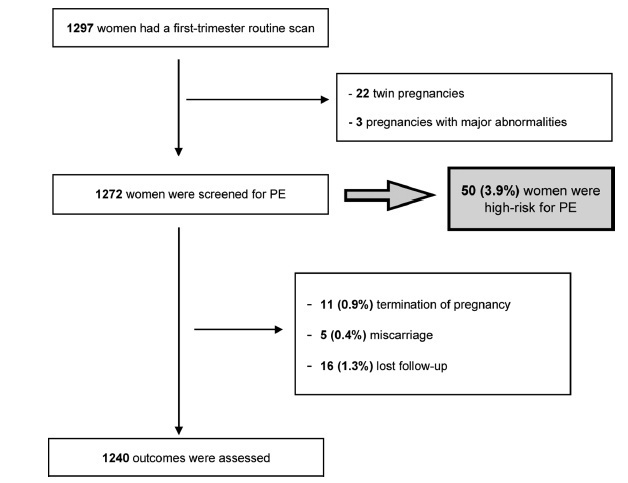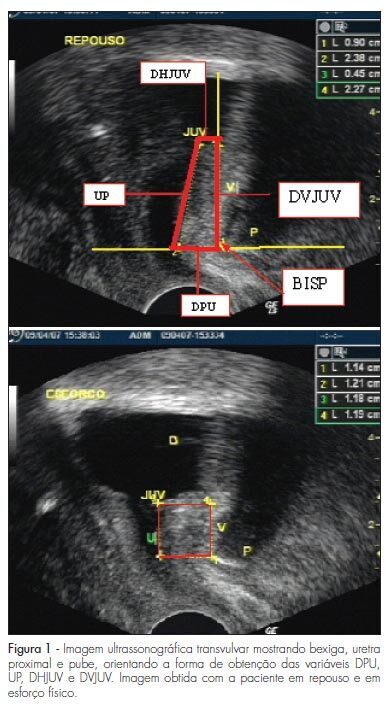Summary
Revista Brasileira de Ginecologia e Obstetrícia. 2017;39(2):39-39
Summary
Revista Brasileira de Ginecologia e Obstetrícia. 2010;32(1):39-46
DOI 10.1590/S0100-72032010000100007
PURPOSE: to evaluate the prevalence of HPV infection and associated factors among women living in the "Baixada Fluminense", state of Rio de Janeiro, Brazil. METHODS: a cross-sectional study conducted on a sample of 2,056 women aged 25-59 years covered by the Family Health Program in the municipalities of Duque de Caxias and Nova Iguaçu, state of Rio de Janeiro, southeastern Brazil. All women were submitted to the Papanicolaou and HPV detection tests in a single session by second-generation hybrid capture from December 2001 to July 2002. The prevalence of HPV was stratified by age, place of residence, schooling, smoking habit, and sexual and reproductive history. The prevalence rates associated with the studied variables were calculated by Multivariate Poisson regression. RESULTS: the prevalence of HPV was 12.3% and 5.0% for high-risk and low-risk HPV types, respectively. A reduction in high-risk HPV prevalence was observed with aging, with an increase in the 55-59 year age range. After adjusting for age, schooling, smoking, early sexual initiation and parity, high-risk HPV infection was associated with not living with a partner (1.4; 95%CI=1.1-1.8) and having more than one sexual partner (an increase of 1.4%; 95%CI=1.1-1.6, for each lifetime sexual partner). CONCLUSIONS: the prevalence of HPV was lower than that reported in other Brazilians studies, most likely because our sample was population-based. HPV infection was associated only with factors related to sexual behavior, but the potential association between HPV infection and smoking still needs to be better understood. Further studies are needed to explore these issues, as well as postmenopausal increased infection rates, and to identify the most prevalent HPV types in the Brazilian population.

Summary
Revista Brasileira de Ginecologia e Obstetrícia. 2013;35(1):39-43
DOI 10.1590/S0100-72032013000100008
A dichorionic twin pregnancy with complete hydatidiform mole and coexistent fetus is a rare and challenging situation, whose pathogenesis has not been yet fully understood. We present a case of a 39-year-old woman who underwent intracytoplasmic sperm injection with two embryos transfer. The 12-week gestation ultrasound examination revealed normal fetus and placenta with features of hydatidiform mole, leading to pregnancy termination. Autopsy and histological examinations diagnosed a complete mole coexisting with a normal fetus, and the genetic analysis showed a diploid fetus with biparental genome and molar tissue with paternal diploidy. This case highlighted that complete molar pregnancies may still occur even though pregnancy is achieved after intracytoplasmic sperm injection. A review of the literature was performed by collecting data from the few similar reported cases and by commenting on the pathogenesis of this rare condition.

Summary
Revista Brasileira de Ginecologia e Obstetrícia. 2020;42(7):390-396
Preeclampsia is a major cause of perinatal and maternal morbidity and mortality. Our objective is to assess the performance of a combined screening test for preeclampsia in the first trimester and the prophylactic use of low-dose aspirin.
Prospective study of all women attending our hospital for the first-trimester screening of aneuploidies, between March 2017 and February 2018 (n = 1,297). The exclusion criteria weremultiple pregnancy andmajor fetal abnormalities. Preeclampsia screening was performed with an algorithm that includes maternal characteristics, and biophysical and biochemical biomarkers. High-risk was defined as a risk ≥ 1:50 of earlyonset preeclampsia (before 34 weeks), in which cases low-dose aspirin (150mg at night) was offered to these women from screening until 36 weeks.
From the 1,272 enrolled participants, the majority were Caucasian (1,051; 82.6%) and multiparous (658, 51.7%). Fifty patients (3.9%) screened high-risk for preeclampsia, and all started a low-dose aspirin regimen, with good compliance (96%). Early-onset preeclampsia was found in 3 pregnant women (0.24%), and total preeclampsia was diagnosed in 25 (2.02%), compared with 28 (0.75%) cases of early preeclampsia (p = 0.0099) and 98 (2.62%) of total preeclampsia (p = 0.2904) before the implementation of screening.
There was a lower incidence of both, early-onset and total preeclampsia, after the introduction of universal screening and prophylactic use of low-dose aspirin. This reduction was statistically significant in early-onset preeclampsia. The association of a first-trimester combined screening model and aspirin prophylaxis appears to be useful in predicting and reducing the incidence of early-onset preeclampsia, in a routine care setting.

Summary
Revista Brasileira de Ginecologia e Obstetrícia. 2018;40(7):390-396
To outline the demographic and clinical characteristics of patients with deep intestinal endometriosis submitted to surgical treatment at a tertiary referral center with a multidisciplinary team, and correlate those characteristics with the surgical procedures performed and operative complications.
A prospective cohort from February 2012 to November 2016 of 32 women with deep intestinal endometriosis operations. The variables analyzed were: age; obesity; preoperative symptoms (dysmenorrhea, dyspareunia, acyclic pain, dyschezia, infertility, urinary symptoms, constipation and intestinal bleeding); previous surgery for endometriosis; Enzian classification; size of the intestinal lesion; and surgical complications.
Themean age was 37.75 (±5.72) years. A total of 7 patients (22%) had a prior history of endometriosis. The mean of the largest diameter of the intestinal lesions identified intraoperatively was of 28.12 mm (±14.29 mm). In the Enzian classification, there was a predominance of lesions of the rectum and sigmoid, comprising 30 cases (94%). There were no statistically significant associations between the predictor variables and the outcome complications, even after the multiple logistic regression analysis. Regarding the size of the lesion, there was also no significant correlation with the outcome complications (p = 0.18; 95% confidence interval [95%CI]:0.94-1.44); however, there was a positive association between grade 3 of the Enzia classification and the more extensive surgical techniques: segmental intestinal resection and rectosigmoidectomy, with a prevalence risk of 4.4 (p < 0.001; 95%CI:1.60-12.09).
The studied sample consisted of highly symptomatic women. A high prevalence of deep infiltrative endometriosis lesions was found located in the rectum and sigmoid region, and their size correlated directly with the extent of the surgical resection performed.

Summary
Revista Brasileira de Ginecologia e Obstetrícia. 2022;44(4):391-397
To determine knowledge, attitude, and preventive (KAP) practices towards the SARS-CoV-2 (COVID-19) pandemic among women in reproductive age seeking to use copper or hormonal intrauterine devices (IUD/LNG-IUS).
We conducted a cross-sectional study in which we applied a questionnaire on 400 women about KAP practices on COVID-19 at the University of Campinas, Campinas, SP, Brazil, from May to August 2020.
The mean (±SD) age of the women was 30.8±7.9 years, and 72.8% of them reported being pregnant at least once. Most women (95%) had heard or read about COVID-19, and their main sources of information were television (91%) and government websites (53%). However, 53% of the women had doubts about the veracity of the information accessed.
Women without a partner and with>12 years of schooling had more information about COVID-19 and on its impact on new pregnancy, and those from high socioeconomic status had a higher chance of maintaining physical distance. Safety, effectiveness, comfort, and absence of hormone in the contraceptive method (in the case of TCu380A IUD) were the main reasons for the participants to seek the service during the pandemic, and the possibility to stop menstrual bleeding was the main reason to choose the LNG-IUS.
Summary
Revista Brasileira de Ginecologia e Obstetrícia. 2009;31(8):391-396
DOI 10.1590/S0100-72032009000800004
PURPOSE: to study the changes in the urethrovesical junction (UVJ) and in the proximal urethra (PU) caused by the Marshall-Marchetti-Krantz-Burch (MMK-B) combined surgery through perineal ultrasonography. METHODS: an interventional, longitudinal and prospective study has been conducted. Thirty-two women with stress urinary incontinence were submitted to perineal ultrasonography before and 30 days after surgery to evaluate the pubo-urethral distance (PUD), the proximal urethra length, the UVJ horizontal distance (UVJHD) and the UVJ vertical distance (UVJVD), the patient being at rest, and in effort during the Valsava manoeuvre. Results have been expressed in mean and standard deviation. The Student's t-test has been used to compare pre and postoperative results whenever the variables fulfilled the normality test criterion; otherwise, the Wilcoxon's paired test has been used. RESULTS: as compared with the preoperative measures, the Marshall-Marchetti-Krantz-Burch surgery has reduced the PUD at rest (14 mm x 4.3 mm) and during effort (20.8 mm x 6.4 mm); has reduced the UVJHD at rest (14 mm x 4.3 mm) and during effort (20.8 mm x 6.4 mm); has increased the PU length at rest (16.7 mm x 19.7 mm) and during effort (1.6 mm x 15.4 mm); and has increased UVJVD during effort (-5.4 mm x 14.8 mm), but has not changed it at rest (16.2 mm x 18.7 mm, p = 0.085). CONCLUSIONS: the Marshall-Marchetti-Krantz-Burch surgery has significantly reduced the urethrovesical junction vertical and horizontal mobility without raising the urethrovesical junction.

Summary
Revista Brasileira de Ginecologia e Obstetrícia. 2001;23(6):391-396
DOI 10.1590/S0100-72032001000600008
Purpose: to evaluate the prescription of prenatal fluoride supplements by gynecologists and obstetricians in Curitiba and metropolitan region. Methods: two hundred and twenty-three (223) questionnaires were distributed to gynecologist-obstetricians. Questions were about the use of fluoride during pregnancy, time since graduation, workplace, among other parameters. Statistical analyses were carried out using Student's t-test, variance analysis (ANOVA), chi² test or Fisher exact test. Results: only 137 questionnaires were returned, which corresponds to 30% (137/441) of the professionals in the studied area and 61.4% (137/223) of the distributed questionnaires. Of the professionals, 47.5% prescribe fluoride as a supplement during pregnancy. Sixty percent of professionals who prescribe fluoride believe that this procedure leads to a better dental formation and caries prevention in the baby. The professionals who do not prescribe prenatal fluoride graduated more recently than the professionals who prescribe it (t=2.27, p<0.05). Moreover, the professionals who work exclusively in the public service prescribe less than those who work only in the private sector (Fisher exact test, p<0.05). Conclusion: there is a large percentage of gynecologist-obstetricians who still prescribe fluoride in the prenatal period, in spite of the recent studies that have not observed any benefit to the child. Therefore, there is a need to update these professionals about the mechanism of action, indication and clinical use of fluoride.